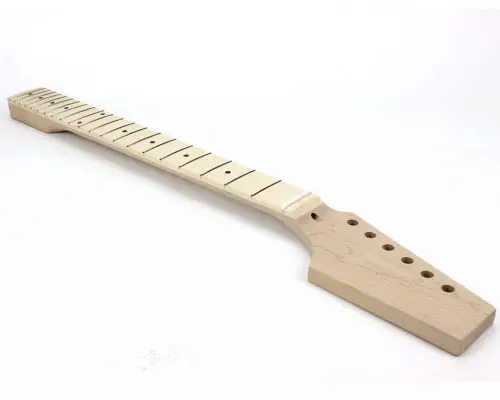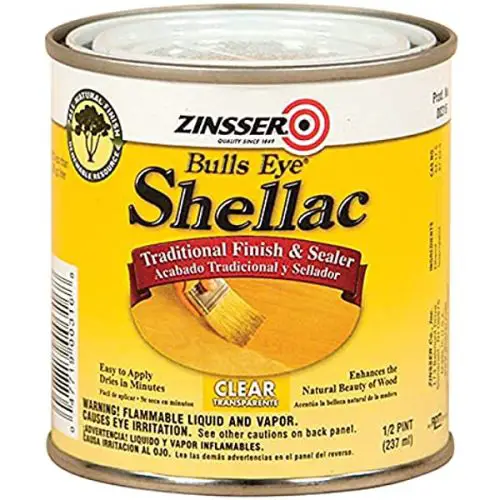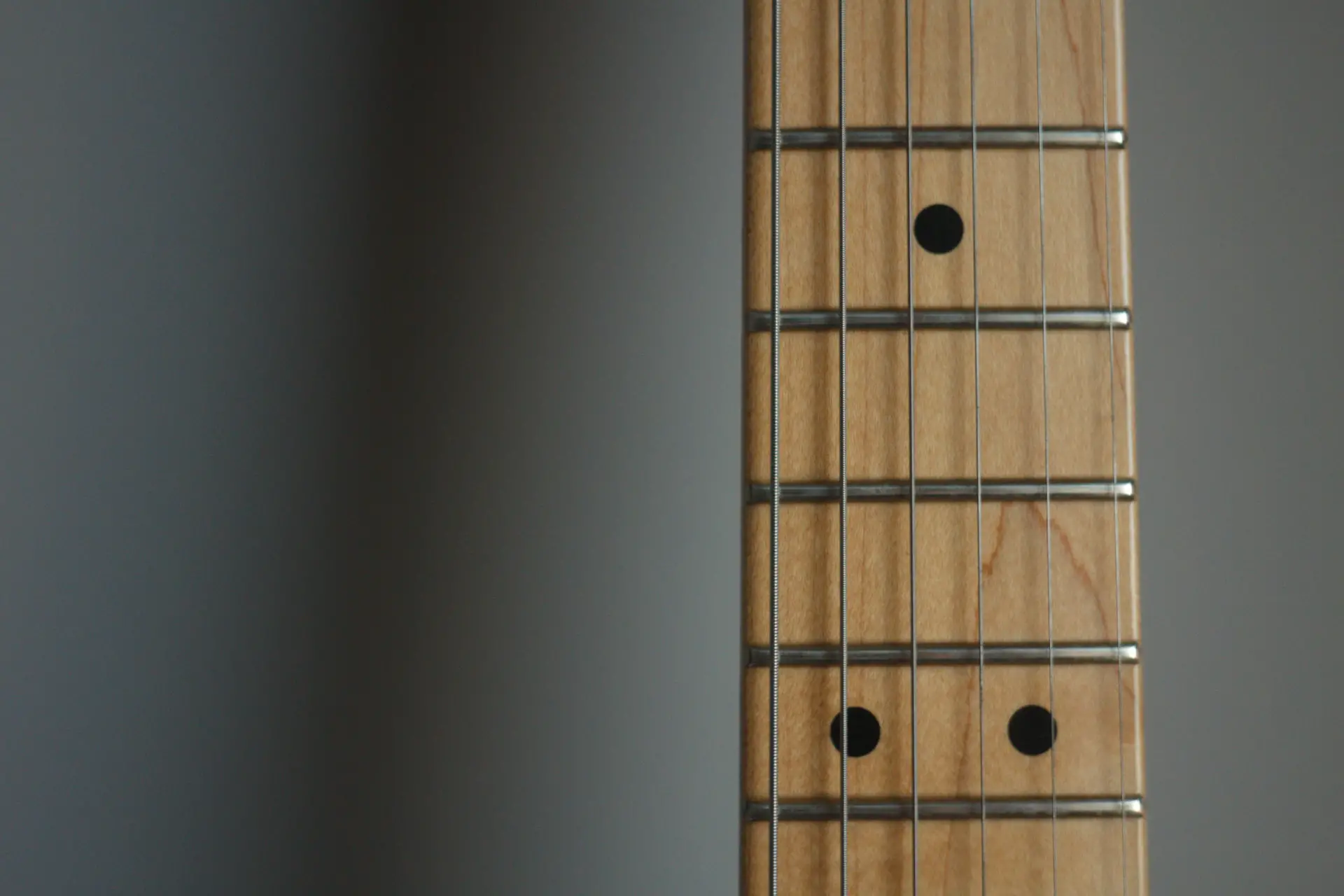Unfinished maple necks are not bad. If you can take care of it and keep it clean, unfinished maple necks can look great and feel great.
However, without proper care, unfinished maple necks can get dirty quickly and get damaged by moisture from your hands.
Actually, it’s not just maple necks – this applies to every unfinished guitar neck.
I personally like finished necks more but I have purchased an aftermarket unfinished maple neck before – so I kinda know the do’s and don’ts around it.
In this article, I am going to discuss unfinished necks in more detail. It should cover everything you want to know or at least everything I wanted to know before buying an unfinished maple neck.
Content:
- Do you need to finish a maple neck?
- Finished Vs Unfinished neck
- How to treat an unfinished maple neck
- How to clean an unfinished maple neck
- Conclusion
Do You Need To Finish A Maple Neck?
You don’t necessarily need to finish a maple neck. An unfinished neck is viable if you can keep it dry, clean it and store it properly when you are done.
Unfinished guitar necks are prone to absorbing moisture – which seep deep into the wood and cause it to degrade over time. If your hand gets sweaty every time you play, then an unfinished guitar neck is not for you.
Also, an unfinished maple neck gets dirty much quickly and will stay dirty for a long time. It’s hard to remove stains and dirt from unfinished necks. Your only option is to lightly sand it. I will cover cleaning later.
The finish of a guitar neck or fretboard is not just for looks. They serve as a protective layer against moisture, change in humidity and general dirt.
If you really like the look and feel of an unfinished neck, then at least coat it with sealer. Majority of “unfinished” necks you purchase are already coated and treated with a sealer – you need to check with the seller or manufacturer.

Unfinished maple neck is prone to absorb moisture and degrade overtime.
Finished Vs Unfinished Neck
If you are still on edge about getting a finished or unfinished neck, then here’s a comparison between the two.
| Finished neck | Unfinished Neck | |
| Tone | Same | Same |
| Protected | Yes | No |
| Maintenance | Not much | Regular cleaning |
| Look | Mostly glossy and darker | Non-glossy and light |
| Cost | More expensive | Cheaper |
| Playability | Sticky if wet | Smooth |
Tone: Finished Vs Unfinished Neck
Finished necks and unfinished necks generally sound the same – as long as they are played with the same body and are made from the same material.
I have both unfinished and finished necks – they both sound great and I like to play with both of them.
The biggest impact to tone in an acoustic guitar is usually the string and body, whereas electric guitar is the pickup and amp. Using a finished or unfinished neck will not impact the sound.
And even if it does, you probably won’t notice it.
Protection & Maintenance: Finished Vs Unfinished Neck
The finishing on a guitar neck or fretboard is primarily for protection against moisture and dirt. The finish seals off the raw wood and will last much longer with low to no maintenance.
For unfinished guitar necks, you need to make sure it’s kept dry (especially from your sweat). And make sure it’s kept inside a case when not in use – this way the wood is not impacted from frequent humidity or temperature changes.
You also need to regularly clean your unfinished guitar necks because it can easily get dirty and stay dirty for a long time (until you clean them).
Look: Finished Vs Unfinished Neck
Truly unfinished necks typically look pale and lighter. The material of course plays a big role in this but generally finished necks are darker and glossier.
Some people swear by the look of the unfinished wood, and I wouldn’t blame them! Unfinished guitar necks can look good and even great for relicing – because they get dirty and worn out easily.
If you are into relicing, then an unfinished neck could be a great option.
Cost: Finished Vs Unfinished Neck
Unfinished necks should be cheaper than the finished versions because the manufacturer needs less process and materials to produce them.
I would expect an unfinished neck to be 30% cheaper than the finished version (with the same wood material and manufacturer).
With finished necks, a manufacturer usually needs a couple of coating layers – including one for protection, for style and for a clear coat.
Manufacturers also need additional time to produce finished necks – each layer needs to be applied multiple times and left to dry before proceeding with the next.
Playability: Finished Vs Unfinished Neck
Unfinished necks should feel smoother than the finished ones – allowing you to glide through them easier and play faster.
With finished necks, your hands may get slightly stuck on the neck when playing. This slows you down a little bit and can be frustrating when playing.
This should impact people with sweaty hands much more. If your hands are dry while playing, both finished and unfinished necks should play just fine.
If you like the look of an unfinished neck but have sweaty hands, I suggest you treat your unfinished neck with a clear sealer – this gives you the look but the wood is sealed off with a protective layer.
I will talk more about this in the next section.
How To Treat An Unfinished Maple Neck?
Most “unfinished” necks you buy from the manufacturer should already have a protective layer – they are already sealed to prevent moisture from getting through.
You should contact the seller about this. If it’s already treated, then you shouldn’t have anything to worry about. Just play it like normal without dedicated maintenance.
If you have confirmed that your neck is indeed unfinished without any sealer or treatment, then follow these steps below to treat the unfinished neck:
- Sand the guitar neck with 600 grit sandpaper to smooth the surface
- Apply clear sealer on the neck using a towel
- Wait till dry
- Apply another coat of the sealer up to 5 coats
- Rub with 0000 steel wool to smooth the surface

Transparent sealer is perfect if you like the looks of unfinished guitar.
How To Clean An Unfinished Maple Neck / Fretboard?
You can clean an unfinished maple neck or fretboard by rubbing it with a fine 0000 steel wool. This rubbing will remove the dirt and even out the surface of your neck or fretboard.
Make sure to tape your fret bars and pickups before proceeding. You don’t want to damage your fret bars and you don’t want the dirt to get stuck on your pickup.
Here’s a great YouTube video that shows how this is done. I personally learned from this video as well and it worked great.
If your guitar neck is truly unfinished without any sealer, then you need to do this regularly. I suggest once a month if you play regularly or once every 3-6 months depending on how much you play.
Conclusion
An unfinished maple neck is not bad – you just have to be careful about it because they get dirty easily and can degrade quickly when moisture seeps into the wood.
Though, most unfinished neck you purchase is most probably already treated – which means you don’t have to worry about it and can play regularly.
If you really like the look of an unfinished neck, then the least you can do is coat it with a layer of sealer.





